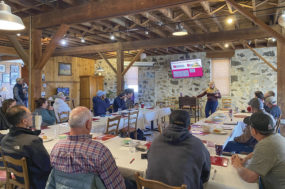On April 21, the director of the Idaho Department of Water Resources (IDWR) issued a revised "methodology order" in the matter of the Surface Water Coalition’s longstanding delivery call. The methodology order is the court-approved process IDWR uses to evaluate water supply conditions, aquifer conditions and irrigation demand. From that calculation, IDWR determines the impacts, or injury, caused by junior groundwater users pumping from the Eastern Snake Plain Aquifer (ESPA).
Under Idaho water law, surface water users with senior water rights have priority over water users with junior rights on the Snake River and ESPA. The rule of law is “First in time, first in right.” On the Snake River, IDWR manages both surface and groundwater resources together as one whole, or “conjunctively,” in calculating impacts each year.
“The department must periodically update the numerous factors involved in our methodology order calculations to ensure it adequately protects the senior water users as outlined in Idaho law,” said Mat Weaver, IDWR deputy director.
IDWR is obligated to update the latest methodology to incorporate new climate and hydrologic data and to ensure adequate protection for senior water users from injury. IDWR’s new methodology revises important elements used to determine in-season and end-of-season injury volumes. It also revises the method used to calculate curtailment dates in a manner that could result in earlier curtailment dates.
Applying the new methodology to April 2023 hydrologic conditions, the department predicts pumping from junior groundwater users in the ESPA will cause a 75,200 acre-foot shortfall to the senior priority surface water users’ water supplies during the irrigation season. Approximately 900 groundwater rights junior to Dec. 30, 1953, not protected by an approved mitigation plan, could be subject to curtailment as this irrigation season develops.
The department is working with the individual water right holders in these circumstances to make them aware of the latest information and how it impacts their water right.
Currently, there are seven approved mitigation plans for the ESPA surface water delivery call. The approved plans came from the Idaho Ground Water Appropriators Inc. (IGWA), Southwest Irrigation District, Goose Creek Irrigation District, Coalition of Cities, the Water Mitigation Coalition and A&B Irrigation District. Because these entities have approved mitigation plans in place, they and the water users they serve will not need to show how they can mitigate for projected water shortfalls if they continue to comply with their plans, the director’s order said.
Junior water users who do not have an approved mitigation plan in place may participate in an approved mitigation plan, such as the plan filed by IGWA, by contacting the groundwater district (GWD) nearest to them and requesting to participate in the GWD for mitigation purposes. This will require acceptance by the GWD, the water user to pay assessments to the GWD, and to adhere to the district’s ongoing mitigation practices.
The 75,200 acre-foot shortfall is based on the April 7 joint forecast of 3.7 million acre-feet of water flow at the Snake River Heise gage from April 1 through July 31. The forecast is calculated by the Bureau of Reclamation and U.S. Army Corps of Engineers, based on mountain snowpack and predicted streamflow runoff. The April 7 forecast flow volume equates to 112% percent of average.
“By law, we have to keep people with senior water rights whole, and we want to make sure the junior groundwater pumpers are aware that despite the settlement agreements between the Surface Water Coalition, IGWA and the Coalition of Cities, if junior groundwater pumpers are not participating in an approved mitigation plan, they could be subject to curtailment this year,” Weaver said.
Much water litigation has resulted over conflicts between Snake River surface water users with senior water rights versus groundwater users with junior water rights in the ESPA. The litigation led to a water delivery call in 2005 by the Surface Water Coalition, which is a coalition of seven surface water irrigation entities that collectively irrigate more than 500,000 acres. Consequently, the director of IDWR is required to issue an order at the beginning of the irrigation season, and then again in early July, determining any shortfall in water supply to the senior surface water right holders, and determining the obligations of junior groundwater pumpers to curtail water use or mitigate for depletions to the holders of senior priority water rights.
Director to hold a contested case hearing
Because of the scope of changes to the new methodology used by IDWR in 2023, and the effect the changes will have on the magnitude and frequency of future injury determinations, the director of IDWR has scheduled a contested case hearing for June 6-10, 2023. At the hearing, parties can argue if and how they believe the director may have erred in making changes to the methodology. Following the hearing, the director may issue a revised order depending on the arguments and evidence presented at the hearing.
Because of the pending hearing, the director will delay issuing a curtailment notice to Snake River junior water users until after the hearing. This means junior groundwater pumpers who do not have approved mitigation plans in place will have a reprieve from curtailment until late June.
Junior water users should wait for specific notice and direction from IDWR as to how their individual water rights are affected by this decision, Weaver said. Junior water right users not in compliance and party to an approved mitigation plan should also be aware of the potential change to their water use given the as-applied order and plan accordingly.
Why is there an injury determination, given the improved snowpack conditions in much of the state?
“Even though this has been a remarkable winter and water year for many basins in Idaho, it has not been uniformly great everywhere,” Weaver said. “The Upper Snake Basin is the basin that supplies water to the reservoir system and the Snake River in the geographic region that’s the focus of the SWC delivery call.
“Because of the past two years of drought, very low reservoir storage carryover from last year, uncertainty as to whether the reservoirs will fill, very low soil moisture conditions from last fall and near-normal snowpack in Upper Snake basins, water supply conditions are still resulting in an injury determination at this time,” Weaver said.
In addition, injury predictions also factor in aquifer storage and discharge conditions. Although this has been a cool snowy year, the ESPA is approaching record-low conditions in response to past groundwater pumping and severe drought. As a result, aquifer flows into the Snake River are approaching record lows. Two other important considerations are:
- IDWR issued a moratorium on the issuance of new water rights in 2022 from King Hill upstream to the headwaters of the Snake River, finding that that surface water and the ESPA are fully appropriated, if not overappropriated.
- Water levels in the ESPA continue to decline.
—From an IDWR press release


.jpg?t=1687979285&width=640)



